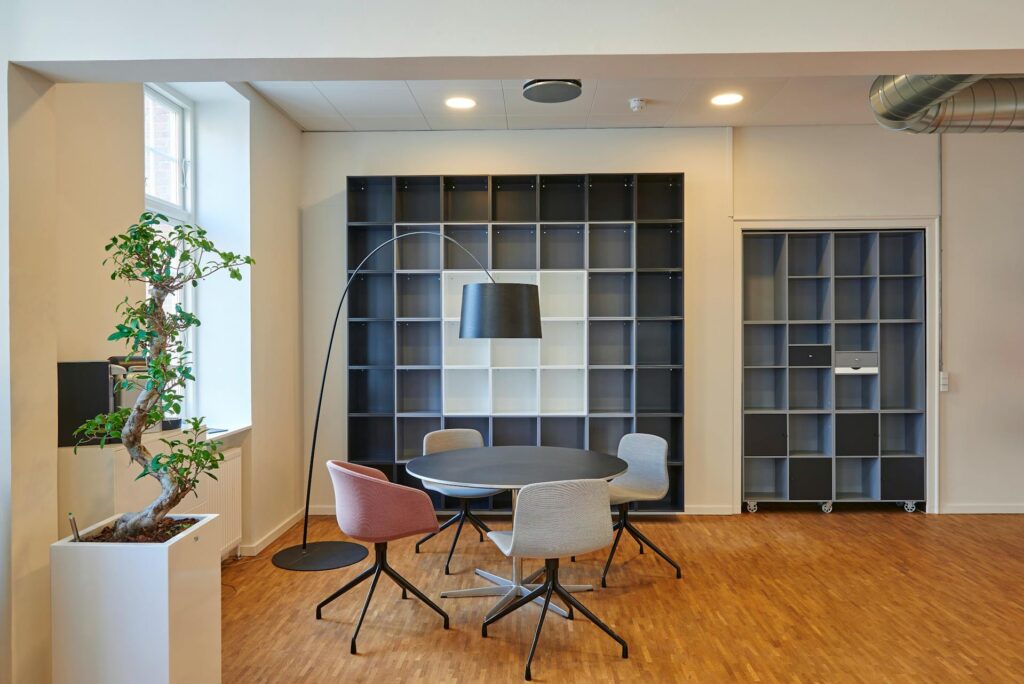
The working dynamics are changing as we go into the digital era, and office interior design is following suit. Businesses are rethinking workplaces in the UK, where innovation and tradition mix, to satisfy the demands of a dynamic and varied workforce. D&G Office Interiors has proven to be one of the best office designers in Cardiff, highly improving your office aesthetics.
These are the top 10 office interior design trends that will influence workspaces in the UK in 2024, from adopting cutting-edge technology to maximising the potential of biophilic design.
Top Office Design Trends In The UK Right Now
1. Biophilic Design In Workspaces
Biophilic design represents a fundamental change in the way we view and use our workspaces. Businesses all around the UK are adopting biophilic integration in 2024 as a way to re-establish a connection between workers and nature in urban settings. Adding greenery to the office creates a sense of energy and tranquillity.
Examples of this include large living walls that act as focus points in welcome rooms and potted plants arranged strategically to line workstations. Furthermore, the focus on optimising natural light balances biophilic components, resulting in environments that are aesthetically pleasing and supportive of worker productivity and well-being.
2. Hybrid Workspaces: Diversity In Your Workspace
The notion of hybrid workspaces—which meet the demands of both in-person and remote employees—was born out of the redefining of the standard office layout brought about by the growth of hybrid work practices in 2024. Modern technology is installed in these dynamic situations to enable smooth communication and cooperation across real-world and virtual barriers.
Regardless of location, teams can generate ideas and exchange insights in real time with collaborative zones’ interactive displays and video conferencing options. Concurrently, quiet areas offer refuges for concentrated work, furnished with materials that attenuate sounds and personal workspaces to reduce disturbances and enhance personal efficiency. Businesses which adopt the hybrid workspace trend enable workers to operate effectively and flexibly, promoting an innovative and adaptable work environment.
3. Wellness Centric: Putting Employees First
In 2024, workplace interior design will be heavily influenced by employee well-being, with companies placing a premium on surroundings that promote the mental, emotional, and physical well-being of their staff. A key component of these spaces is ergonomic equipment, such as monitor arms, adjustable standing desks, and ergonomic seats that support good posture and lower the risk of musculoskeletal problems.
Furthermore, designated wellness areas provide areas with cosy seats, soothing lighting, and mindfulness tools for rest and renewal. Employees have access to facilities that put self-care and stress management first, whether it’s taking a break to meditate or just relaxing in a peaceful environment. Businesses are building a resilient culture in addition to a happier and healthier staff by implementing wellness-centric design concepts.
4. Sustainability is King
By 2024, sustainability will have already moved from being a trendy term to a necessary component of workplace interior design. Companies all throughout the UK are adopting sustainable practices to reduce their environmental impact and help create a more environmentally friendly future. This involves choosing environmentally friendly products, such as low VOC paints, recyclable plastics, and repurposed wood, which not only cut waste but also improve worker health inside.
By lowering energy use and carbon emissions, energy-efficient lighting solutions and smart sensors improve sustainability initiatives even more. In addition, companies are reducing the quantity of garbage they send to landfills by putting in place waste reduction programmes and composting facilities. Businesses are exhibiting their dedication to environmental stewardship and promoting a responsible corporate culture by giving sustainability priority when designing their workplace spaces.
5. Technology Integrated Workspace
By 2024, workplace interiors must integrate technology, since it is now a must in the digital era. Enterprises are utilising intelligent technologies to improve productivity, communication, and teamwork in the work environment. This entails deploying Internet of Things (IoT) enabled sensors to keep an eye on the surroundings and optimise energy use, as well as digital workstations outfitted with wireless networking and touchscreen displays for smooth workflow.
Technologies like virtual reality (VR) and augmented reality (AR) are also being used to create immersive experiences for client meetings, training sessions, and presentations. Furthermore, whether a team is working remotely or in the office, they can connect and cooperate with ease thanks to integrated communication platforms and tools. Businesses are future-proofing their workplaces and enabling staff to work smarter, not harder, by adopting technology-enabled workspaces.
6. Get Creative With Colour Schemes
In 2024, offices are ditching the dullness of neutral colour schemes in favour of striking and eye-catching colours that give their spaces individuality and vibrancy. Businesses are intentionally utilising colour to elicit feelings, spark creativity, and represent corporate identity through everything from colourful accent walls to creative colour blocking and carefully chosen colour schemes.
According to research, colour may have a significant effect on mood and productivity. While some hues encourage attention and concentration, others foster creativity and teamwork. Businesses are establishing dynamic and engaging workspaces that excite and inspire workers and promote a culture of innovation and happiness by implementing expressive colour schemes into their office design.
7. Turn Your Office Into A Home
Offices in 2024 are adopting homey features to create welcoming and pleasant spaces that enhance employee well-being and happiness as work and home life becomes more blurred. While communal kitchens with coffee makers and snack bars promote social contact and cooperation, cosy breakout rooms with plush sofas and lounge chairs offer places for unofficial meetings and leisure.
Furthermore, homely items like wall paintings, toss cushions and area rugs provide office spaces character and warmth while fostering a sense of community and belonging among staff members. Businesses are creating rooms that seem less like a sterile work environment and more like a warm extension of home by introducing domestic comforts into their workplace design. This is boosting employee engagement and loyalty.